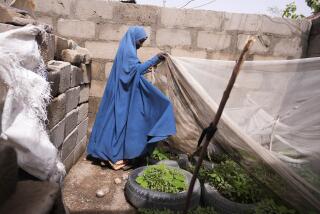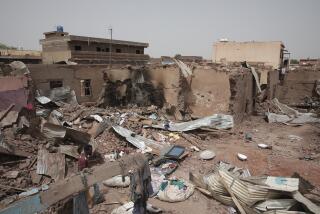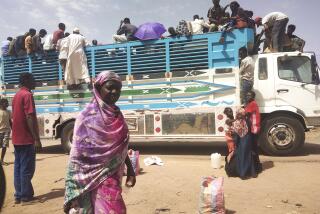Food Aid Begins Flowing in Niger
- Share via
DOUKOUKOUNEY, Niger — When the women of this village heard that free food was on the way, they were overjoyed at the thought that, for the first time in months, they would not have to worry about how to feed their children.
“We have been hungry for more than a year,” said Mariam Garba, 35, a mother of seven who was nursing a baby as she waited in line for the aid being distributed this week. “Many times I would sit down and think, ‘How I am going to feed my children?’ It kept me awake at night.”
But what the women from Doukoukouney and neighboring villages received disappointed many of them.
Each family’s ration consisted of 220 pounds of cereal, 33 pounds of pulses, or edible seeds, and 5 quarts of cooking oil. However, Garba said some extended families had as many as 30 members, with two wives, many children and grandparents. Her own family, she said, consists of more than 30 people, but she is the only one registered to receive the aid.
“Now all the women are worried and complaining,” she said Wednesday, adding that the food she received would last only a few days. “They took just one woman in each family. She’ll share the food, but I don’t think it will be enough for the whole family.”
Marcus Prior, spokesman for the World Food Program, said that the U.N. agency’s distributions to villages such as Doukoukouney, near the southern city of Maradi, were based on the village population and that the aid handed out should last a month. Each ration was designed for a family of seven, based on surveys of the average family size in Niger.
“The bottom line is that there should be enough food in the village, and in the traditional society of which we are speaking it will be shared around,” Prior said. “In the long term it should make its way to those who need it most.”
“The important thing is that they are getting food now,” he added. “Our biggest challenge is to get as many of those distributions done as quickly as possible.”
As the first general free food deliveries began recently, some analysts argued that the United Nations, the Niger government and other humanitarian groups had misread the crisis, played it down and delayed too long in handing out aid desperately needed to stave off starvation amid rising food prices.
The slow response of international donors to the U.N. appeals had elicited an initial barrage of criticism. But many observers argue that it is the humanitarian agencies’ failure to analyze the hunger problem and respond adequately that has contributed to the crisis.
These critics contend that even if donations had arrived sooner, the money probably would have been misspent because the key players -- the Niger government, U.N. and other agencies -- had their priorities wrong.
The Humanitarian Policy Group, an analytical unit at the London-based Overseas Development Institute, said fears that distributing free food would distort the market or harm long-term development projects “seem to have resulted in extreme reluctance to move from subsidized food to free food distribution.”
A recent briefing paper by the group says the central strategy of the U.N. Flash Appeal in May appears to have been misconceived, based largely on providing subsidized food and fodder rather than giving out free food.
“Fears about creating dependency should not be a justification for failing to provide relief when it is needed,” the paper says. “This is not just a case of donors failing to provide resources quickly enough. What we are seeing now is the normal tendency for different parts of the system to blame each other or even to deny that there is a crisis at all.”
Niger’s president, Mamadou Tandja, fueled perceptions that his government had misjudged the crisis with recent comments that “the people of Niger look well-fed.” He said food shortages were normal in the nation and complained that opposition politicians and humanitarian agencies were exploiting the crisis.
“It is by deception that such agencies receive funding,” he said.
His remarks puzzled agencies that have been working closely with the government on the crisis.
Niger, with much of its territory in the Sahara desert south of Algeria, relies heavily on subsistence agriculture. It is the second-poorest country after Sierra Leone, according to U.N. statistics, with 61% of its population living on less than $1 a day.
Sanoussi Jackou, founder of the Niger Party for Self-Management and a prominent member of parliament, said the president had little contact with the people or understanding of their problems.
“He’s cut off from reality,” he said in an interview in Niamey, the capital. “He doesn’t want people to say there is hunger.
“There is a superstition problem in Africa. When you have a chief and there is good rain and a good harvest during his rule, people say the chief has good luck and brought good rains. If there’s no rain and there’s no harvest, people say he’s a bad chief and they can chase him away.”
An early end to rains last year and a locust plague caused the country’s 2004 harvests to fall 11% below the five-year average, and food prices more than doubled in some of the hardest-hit areas. Overall food prices were up 75% to 80% compared with the five-year average, according to the Humanitarian Policy Group paper.
The group’s briefing says agencies and the Niger government focused on the fact that food was available on the market rather than that it was inaccessible to most people.
“In a country like Niger, where a large percentage of the population lives in absolute poverty and relies on purchased food during the hungry season, a near-doubling of food prices should have triggered an earlier response,” the paper concludes. “It should also have called into serious question the wisdom of a strategy that relied so heavily on trying to subsidize food prices, particularly when these prices kept rising.”
John Staaz, a professor of agricultural economics at Michigan State University who has been working on the issue of food security with the government of neighboring Mali, said authorities there took firmer steps than those in Niger to stem the crisis, distributing not only free food but also fodder for livestock.
“They recognized that it was not just a human nutritional crisis but a livestock crisis that would translate into an income crisis for those who had livestock,” he said. “My impression is that they managed the crisis a lot better.”
Malian authorities also set up slaughter facilities so thin animals could be killed before they died, and the meat dried and sold, a move that prevented livestock prices from dropping too low.
“There are still a lot of herders hurting in Mali,” Staaz said, “but it is not as bad as it could have been.”
More to Read
Sign up for Essential California
The most important California stories and recommendations in your inbox every morning.
You may occasionally receive promotional content from the Los Angeles Times.










